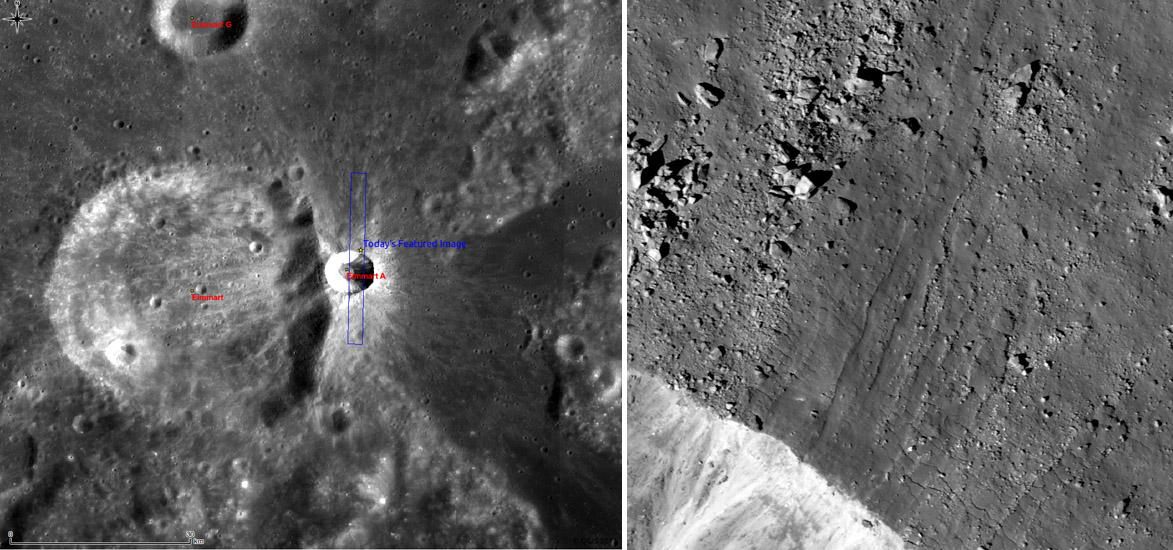Difference between revisions of "July 29, 2011"
| (3 intermediate revisions by the same user not shown) | |||
| Line 1: | Line 1: | ||
__NOTOC__ | __NOTOC__ | ||
=Truncated= | =Truncated= | ||
| + | <!-- Start of content --> | ||
<!-- ws:start:WikiTextHeadingRule:0:<h1> --> | <!-- ws:start:WikiTextHeadingRule:0:<h1> --> | ||
<!-- ws:start:WikiTextLocalImageRule:6:<img src="/file/view/LPOD-Jul29-11.jpg/243332629/LPOD-Jul29-11.jpg" alt="" title="" /> -->[[File:LPOD-Jul29-11.jpg|LPOD-Jul29-11.jpg]]<!-- ws:end:WikiTextLocalImageRule:6 --><br /> | <!-- ws:start:WikiTextLocalImageRule:6:<img src="/file/view/LPOD-Jul29-11.jpg/243332629/LPOD-Jul29-11.jpg" alt="" title="" /> -->[[File:LPOD-Jul29-11.jpg|LPOD-Jul29-11.jpg]]<!-- ws:end:WikiTextLocalImageRule:6 --><br /> | ||
<em>images from [http://lroc.sese.asu.edu/news/index.php?/archives/405-Rootless-impact-melt-flows.html#extended Lunar Reconnaissance Orbiter Featured Image] (NASA/GSFC/Arizona State University)</em><br /> | <em>images from [http://lroc.sese.asu.edu/news/index.php?/archives/405-Rootless-impact-melt-flows.html#extended Lunar Reconnaissance Orbiter Featured Image] (NASA/GSFC/Arizona State University)</em><br /> | ||
<br /> | <br /> | ||
| − | Sitting on the northeast rim of the Crisium Basin is Eimmart, an old degraded crater with a bright crater, Eimmart A, | + | Sitting on the northeast rim of the Crisium Basin is Eimmart, an old degraded crater with a bright crater, Eimmart A, |
| − | just touching its rim. A new LRO image release shows flows extending down slope from the sharp rimcrest of "A". | + | just touching its rim. A new LRO image release shows flows extending down slope from the sharp rimcrest of "A". |
| − | These flows presumably are impact melt that originally started where ejected melt splashed onto the rim, ponded a | + | These flows presumably are impact melt that originally started where ejected melt splashed onto the rim, ponded a |
| − | little and then flowed downhill. But these flows have been beheaded - their starting points are missing. Presumably | + | little and then flowed downhill. But these flows have been beheaded - their starting points are missing. Presumably |
| − | the original starting points have slid down into the floor of Eimmart A - in fact, hairline faults concentric to the rim | + | the original starting points have slid down into the floor of Eimmart A - in fact, hairline faults concentric to the rim |
| − | are visible showing where future rim collapses may occur, truncating more of these melt flows. EImmart A is visible | + | are visible showing where future rim collapses may occur, truncating more of these melt flows. EImmart A is visible |
| − | from Earth in backyard telescopes. Look for it in a few days when illumination returns to the eastern limb, and imagine | + | from Earth in backyard telescopes. Look for it in a few days when illumination returns to the eastern limb, and imagine |
| − | what it was like when molten red impact melt flowed down the rim. <br /> | + | what it was like when molten red impact melt flowed down the rim. |
| + | <br /> | ||
<br /> | <br /> | ||
<em>[mailto:tychocrater@yahoo.com Chuck Wood]<br /> | <em>[mailto:tychocrater@yahoo.com Chuck Wood]<br /> | ||
| − | I remember that one of the lunar meteorites has an unusual composition that matched a unique chemical anomaly | + | I remember that one of the lunar meteorites has an unusual composition that matched a unique chemical anomaly |
| − | at Eimmart. If so, we may have a piece of the Moon ejected during the formation of Eimmart A. But I can't find which | + | at Eimmart. If so, we may have a piece of the Moon ejected during the formation of Eimmart A. But I can't find which |
| − | meteorite it was - does any one know?</em><br /> | + | meteorite it was - does any one know?</em> |
| + | <br /> | ||
<br /> | <br /> | ||
<strong>Related Links</strong><br /> | <strong>Related Links</strong><br /> | ||
| − | Rükl plate [ | + | Rükl plate [https://the-moon.us/wiki/R%C3%BCkl_27 27]<br /> |
<br /> | <br /> | ||
| + | <hr /> | ||
<p><b>Yesterday's LPOD:</b> [[July 28, 2011|Big Guns]] </p> | <p><b>Yesterday's LPOD:</b> [[July 28, 2011|Big Guns]] </p> | ||
<p><b>Tomorrow's LPOD:</b> [[July 30, 2011|Endless Moons]] </p> | <p><b>Tomorrow's LPOD:</b> [[July 30, 2011|Endless Moons]] </p> | ||
| − | < | + | <!-- End of content --> |
| + | {{wiki/ArticleFooter}} | ||
Latest revision as of 17:49, 13 October 2018
Truncated

images from Lunar Reconnaissance Orbiter Featured Image (NASA/GSFC/Arizona State University)
Sitting on the northeast rim of the Crisium Basin is Eimmart, an old degraded crater with a bright crater, Eimmart A,
just touching its rim. A new LRO image release shows flows extending down slope from the sharp rimcrest of "A".
These flows presumably are impact melt that originally started where ejected melt splashed onto the rim, ponded a
little and then flowed downhill. But these flows have been beheaded - their starting points are missing. Presumably
the original starting points have slid down into the floor of Eimmart A - in fact, hairline faults concentric to the rim
are visible showing where future rim collapses may occur, truncating more of these melt flows. EImmart A is visible
from Earth in backyard telescopes. Look for it in a few days when illumination returns to the eastern limb, and imagine
what it was like when molten red impact melt flowed down the rim.
Chuck Wood
I remember that one of the lunar meteorites has an unusual composition that matched a unique chemical anomaly
at Eimmart. If so, we may have a piece of the Moon ejected during the formation of Eimmart A. But I can't find which
meteorite it was - does any one know?
Related Links
Rükl plate 27
Yesterday's LPOD: Big Guns
Tomorrow's LPOD: Endless Moons
COMMENTS?
Register, Log in, and join in the comments.



